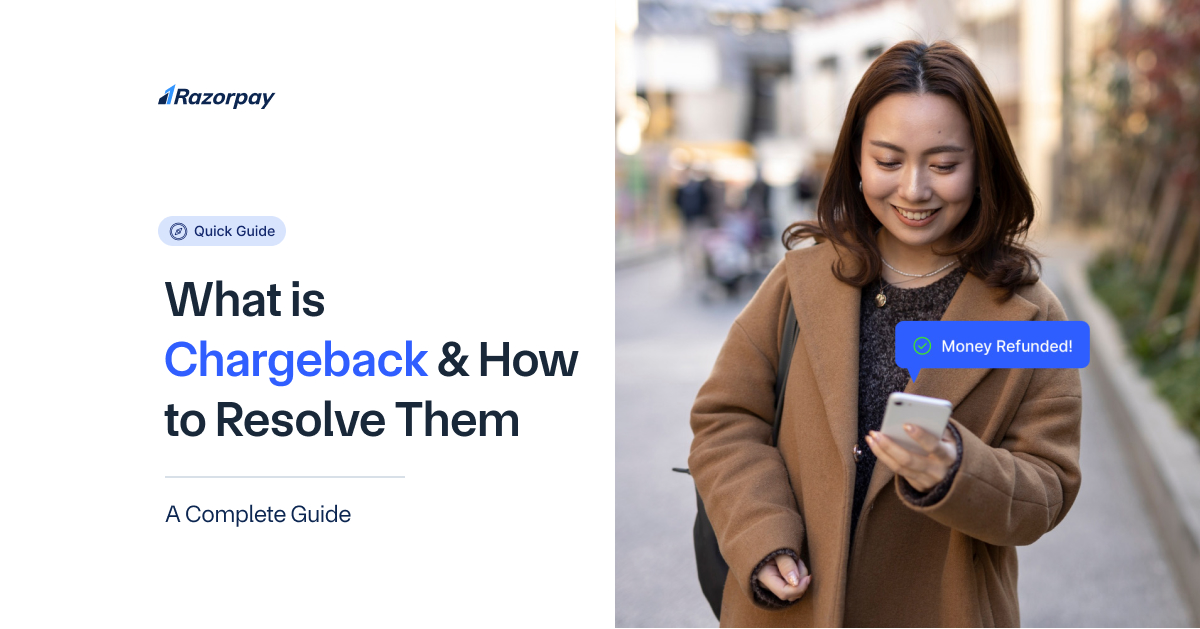Let’s say you run an online store in Singapore, and just when you’re celebrating a big sale, you get notified that the customer has reversed the transaction. The money’s gone. You’ve shipped the product. And now, you’re left with both the loss and the confusion.
That’s a chargeback — one of the trickiest hurdles in digital payments.
While they protect consumers, chargebacks can significantly impact a merchant’s revenue, reputation, and long-term sustainability.
In this blog, we’ll break down what chargebacks are, why they happen, the different types, and most importantly — how your business can resolve and prevent them efficiently in the Singapore market.
What is Chargeback?
A chargeback is a reversal of a credit or debit card transaction initiated by the cardholder’s bank. Customers typically request chargebacks when they detect fraud, are unhappy with a purchase, or do not recognize a transaction. While it acts as a consumer protection tool, frequent chargebacks can lead to severe consequences for merchants, including financial penalties and loss of payment processing privileges.
Chargebacks in Singapore: Regulatory and Market Considerations
In Singapore, the Payment Services Act (PSA) mandates fair dispute resolutions and strong fraud protection mechanisms by licensed payment service providers. The Monetary Authority of Singapore (MAS) supervises these providers, ensuring they offer timely resolution and consumer compensation in the event of unauthorized transactions.
Local payment methods like PayNow, NETS, GrabPay, and BNPL platforms have their own dispute processes, which may differ from traditional card chargebacks. Merchants should stay updated on these policies to maintain compliance and minimize disputes.
How Do Chargebacks Work?
Chargebacks come into play after a transaction is completed — the payment has been processed, the funds have reached the business’s account, and the charge is reflected on the customer’s credit card statement.
That’s when the chargeback process begins. Here’s a closer look at how it works:
- Customer Initiates Dispute: The cardholder contacts their bank to dispute a transaction.
- Bank Reviews: The issuing bank investigates the claim and may issue a provisional credit to the customer.
- Merchant Notified: The merchant receives a chargeback notice and is asked to provide compelling evidence.
- Merchant Responds: The merchant submits proof, such as receipts, communication logs, or shipping confirmations.
- Bank Decision: Based on the evidence, the bank decides whether to reverse or uphold the chargeback.
This process involves coordination between the merchant, customer, bank, and card network.
Chargeback Vs Refund: What’s The Difference
While both refunds and chargebacks result in the customer getting their money back, the key difference lies in who initiates the process. A refund is voluntarily issued by the business, while a chargeback is enforced by the customer’s bank or card provider. Beyond who triggers the reversal, there are several other important distinctions that set the two apart:
| Aspect | Chargeback | Refund |
| Initiated By | Customer via issuing bank | Merchant voluntarily |
| Reason | Fraud, dissatisfaction, error | Dissatisfaction, product return |
| Control | Bank-driven | Merchant-driven |
| Cost to Merchant | High (fees, penalties) | Lower |
| Resolution Time | Up to 90 days | Usually immediate or within days |
| Impact on Reputation | Negative | Neutral or positive |
Types of Chargebacks
| Type | Description | Example |
| Fraudulent | Unauthorized transaction made with stolen card details | Credit card theft used for large online order |
| Merchant Error | Mistakes in billing or service delivery | Double billing, incorrect amount charged |
| Friendly Fraud | Legitimate transactions disputed dishonestly by the customer | Claiming item wasn’t received when it was |
Singapore Examples:
- PayNow QR payment for event ticket disputed despite successful entry.
- BNPL transaction on a fashion app reversed due to buyer’s regret.
- GrabPay used at a store, then falsely claimed as unrecognized.
Chargeback Examples
-
Unauthorized Transaction – Stolen Credit Card
Karan’s wallet is stolen while commuting. He quickly blocks his debit card, but not before the thief uses it to make multiple online purchases totaling ₹10,000 at different e-commerce sites within an hour. When Karan checks his bank statement and spots the unfamiliar charges, he reports the theft and files a chargeback, stating the transactions were unauthorized. The bank launches an investigation, confirms that the purchases were made after the card was reported lost, and processes the chargeback. Karan is refunded the ₹10,000, and the merchants involved may bear the cost of the loss, depending on the card network’s policies.
-
Merchant Error – Double Billing
Ayan pays ₹3,000 for a dinner bill via a restaurant’s card machine. However, due to a technical glitch, his card is charged twice — once when the waiter swipes, and again when the transaction shows as failed and is reattempted. Though the receipt shows only one charge, Ayan spots the duplicate payment on his credit card statement. The restaurant refuses to accept the error, claiming the payment was only processed once. Ayan raises a chargeback for the second ₹3,000 charge, and the bank reviews the transaction logs. Upon confirming the double billing, the bank refunds ₹3,000 to Ayan’s account.
-
Friendly Fraud – False Non-Delivery Claim
Tina orders a smartphone case worth ₹2,000 from a reputed online retailer. It is delivered and marked as received, with proof of delivery and a photo from the courier app showing it left at her doorstep. However, Tina claims she never got the package and raises a chargeback for non-delivery. The merchant provides delivery confirmation, time stamps, and GPS location logs to the bank. If the evidence holds up, the chargeback is declined, and the ₹2,000 is not refunded.
What Are The Common Reasons For Chargeback?
- Fraudulent Transactions
Chargebacks often stem from unauthorized use of a credit or debit card—typically due to stolen card information or identity theft. The cardholder reports the transaction as fraud since they didn’t make the purchase.
- Processing Errors
These include technical issues like duplicate billing, incorrect amounts charged, or transactions processed after cancellation. Even small errors can lead to disputes if not addressed quickly..
- Product/Service Dissatisfaction
Customers may raise a chargeback if they receive a damaged product, something different from what was advertised, or if the service fails to meet expectations. It’s often seen as a last resort when refunds aren’t offered.
- Non-Delivery
If the buyer doesn’t receive the product or service they paid for—due to delays, lost shipments, or cancellations—they may file a chargeback claiming non-delivery.
- Subscription Confusion
Recurring charges from forgotten or unclear subscriptions (like auto-renewals without reminders) can confuse customers, leading them to dispute the payment, especially if cancellation options were not clear.
Why Is a Chargeback Being Filed Against You?
Businesses often face chargebacks due to:
- Unauthorized transactions (card fraud).
- Incorrect billing or duplicate charges.
- Misleading or unclear product descriptions.
- Shipping delays or lost packages.
- Customers abusing chargeback rights (friendly fraud).
Understanding these causes helps identify weak spots in your service, billing, or fulfillment process.
How Much Do Chargebacks Cost Businesses?
Chargebacks can be expensive—not just in fees, but also in lost revenue and operational strain. Each chargeback typically costs between $20 to $50 (and sometimes up to $100 or more), depending on the payment processor and the merchant’s risk level. On top of that, businesses lose the original transaction amount and may also bear additional costs like shipping, inventory, and labor. Exceeding a certain chargeback threshold can even lead to penalties or account termination.
How to Dispute a Chargeback?
Disputing a chargeback can feel daunting, but with the right process, businesses can improve their chances of winning the case. The key lies in acting quickly, providing strong documentation, and following your payment processor’s specific dispute protocols.
Below is a step-by-step guide to help you navigate the chargeback dispute process effectively:
Step 1: Review the Chargeback Notification
Start by reading the chargeback notice carefully. Understand the reason code provided by the issuing bank, as it dictates what kind of evidence you’ll need to collect.
Step 2: Gather Supporting Evidence
Build a strong case with clear, factual documentation. This may include:
- Transaction receipts and order confirmation
- Proof of delivery or service fulfillment (e.g., tracking ID, delivery signature)
- Customer communication (emails, chat logs)
- Refund/cancellation policy that was shared with the customer
Step 3: Prepare a Rebuttal Letter
Draft a concise, professional response explaining your side of the story. Address the dispute reason directly and highlight how the evidence supports your claim.
Step 4: Submit the Dispute
Use your payment processor’s dashboard to upload your evidence and rebuttal. Ensure you meet the submission deadline—late responses are typically rejected.
Step 5: Track and Follow Up
Stay updated on the dispute status. In some cases, additional information may be requested. Keep communication lines open with your payment provider for any updates or final decisions.
How Long Does it Take to Dispute a Chargeback?
The chargeback process can take 30 to 90 days, depending on:
- Card network (Visa, Mastercard, etc.)
- Payment processor policies
- Dispute complexity
Merchants usually have 7 to 30 days to respond. Delays may escalate the case to arbitration, extending the timeline.
Ways to Prevent Chargeback
Preventing chargebacks starts long before a dispute ever arises. By building trust, setting clear expectations, and securing your transactions, businesses can reduce the risk of chargebacks and protect their bottom line. Here are some ways to prevent chargebacks:
- Use clear and detailed billing descriptors.
- Communicate refund policies upfront.
- Provide top-notch customer service.
- Use fraud detection and CVV verification.
- Ship with tracking and delivery confirmation.
- Avoid misleading advertisements.
- Offer easy cancellations and returns.
Proactive prevention saves businesses from revenue loss and operational strain.
Final Thoughts
Chargebacks are an unavoidable part of online commerce, but understanding their causes, costs, and resolution process can help businesses stay ahead. By implementing prevention strategies and managing disputes effectively, merchants in Singapore can protect their revenue and reputation.
Stay informed. Stay secure. Minimise chargebacks.
FAQs
1. Can businesses prevent chargebacks?
Yes, by following best practices like fraud detection tools, clear policies, and excellent service, you can reduce the likelihood of chargebacks.
2. How can businesses reduce fraud-related chargebacks?
Use address verification (AVS), CVV checks, 3D Secure, and monitor suspicious activity regularly.
3. Is chargeback a refund?
No. A chargeback is initiated by the bank, while a refund is voluntarily processed by the merchant.
4. Who pays chargeback fees?
The merchant bears the chargeback fees, which are charged by the bank or payment processor.
5. Is there a limit for initiating a chargeback?
Most banks allow customers to file a chargeback within 120 days of the transaction, but it can vary.
6. How does Singapore’s Payment Services Act affect chargeback disputes?
It ensures consumers have access to fair and timely dispute resolutions and mandates compliance from payment service providers.
7. Are chargeback processes different for PayNow or NETS transactions?
Yes. Local payment methods like PayNow and NETS follow separate dispute policies, often with shorter timelines and different resolution procedures.




